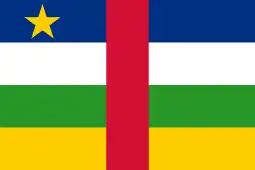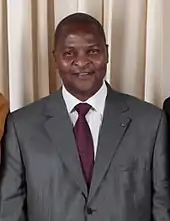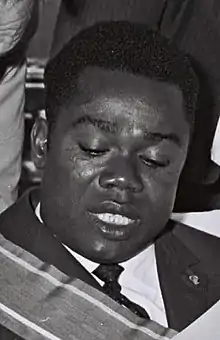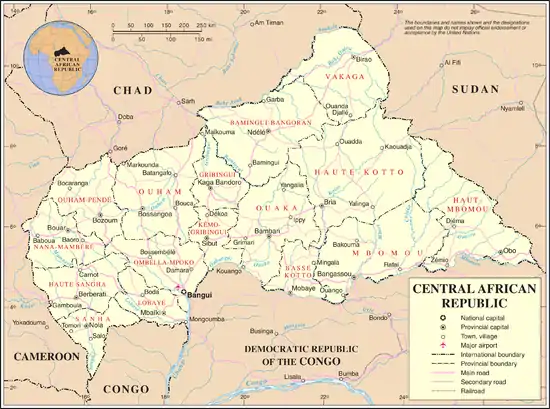The Central African Republic Portal
The Central African Republic (CAR), formerly known as Ubangi-Shari, is a landlocked country in Central Africa. It is bordered by Chad to the north, Sudan to the northeast, South Sudan to the east, the Democratic Republic of the Congo to the south, the Republic of the Congo to the southwest, and Cameroon to the west. Bangui is the country's capital and largest city, at the border of the Democratic Republic of the Congo. The Central African Republic covers a land area of about 620,000 square kilometres (240,000 sq mi). , it had an estimated population of around 5.5 million. , the Central African Republic is the scene of a civil war, which has been ongoing since 2012. Most of the Central African Republic consists of Sudano-Guinean savannas, but the country also includes a Sahelo-Sudanian zone in the north and an equatorial forest zone in the south. Two-thirds of the country is within the Ubangi River basin (which flows into the Congo), while the remaining third lies in the basin of the Chari, which flows into Lake Chad. What is today the Central African Republic has been inhabited since at least 8,000 BCE. The country's borders were established by France, which ruled the country as a colony starting in the late 19th century. After gaining independence from France in 1960, the Central African Republic was ruled by a series of autocratic leaders, including an abortive attempt at a monarchy. By the 1990s, calls for democracy led to the first multi-party democratic elections in 1993. Ange-Félix Patassé became president, but was later removed by General François Bozizé in the 2003 coup. The Central African Republic Bush War began in 2004 and, despite a peace treaty in 2007 and another in 2011, civil war resumed in 2012. The civil war perpetuated the country's poor human rights record: it was characterized by widespread and increasing abuses by various participating armed groups, such as arbitrary imprisonment, torture, and restrictions on freedom of the press and freedom of movement. (Full article...) Selected article -
Cahier Africain ([kaje afʁikɛ̃], "African Notebook") is a 2016 documentary film by Heidi Specogna, a Swiss filmmaker. Beginning in 2008, Specogna's long-term observation follows the lives of two young Central African woman, Amzine and Arlette. The film was prompted by the discovery of a small exercise book, full of courageous testimonies by more than 300 victims of war crimes committed by Central African mercenaries during armed conflict between October 2002 and March 2003. (Full article...)
General images -The following are images from various Central African Republic-related articles on Wikipedia.
MapDid you know (auto-generated)
| ||||||||||||||||||||||||||||||||||||||||||||||||||||||||||||||||
| Rank | City / town | Préfecture | Population (2003 census) |
|---|---|---|---|
| 1 | Bangui | — | 622,771 |
| 2 | Bimbo | Ombella-M'Poko | 124,176 |
| 3 | Berbérati | Mambéré-Kadéï | 76,918 |
| 4 | Carnot * | Mambéré-Kadéï | 45,421 |
| 5 | Bambari | Ouaka | 41,356 |
| 6 | Bouar | Nana-Mambéré | 40,353 |
| 7 | Bossangoa | Ouham | 36,478 |
| 8 | Bria | Haute-Kotto | 35,204 |
| 9 | Bangassou | Mbomou | 31,553 |
| 10 | Nola | Sangha-Mbaéré | 29,181 |
| 11 | Kaga-Bandoro | Nana-Grébizi | 24,661 |
| 12 | Sibut | Kémo | 22,419 |
| 13 | Mbaïki | Lobaye | 22,166 |
| 14 | Bozoum | Ouham-Pendé | 20,655 |
Topics
Associated Wikimedia
The following Wikimedia Foundation sister projects provide more on this subject:
-
 Commons
Commons
Free media repository -
 Wikibooks
Wikibooks
Free textbooks and manuals -
 Wikidata
Wikidata
Free knowledge base -
 Wikinews
Wikinews
Free-content news -
 Wikiquote
Wikiquote
Collection of quotations -
 Wikisource
Wikisource
Free-content library -
 Wikiversity
Wikiversity
Free learning tools -
 Wikivoyage
Wikivoyage
Free travel guide -
 Wiktionary
Wiktionary
Dictionary and thesaurus
-
 List of all portals
List of all portals -

-

-

-

-

-

-

-

-

-
 Random portal
Random portal -
 WikiProject Portals
WikiProject Portals






.jpg.webp)

.jpg.webp)












.svg.png.webp)

.jpg.webp)












